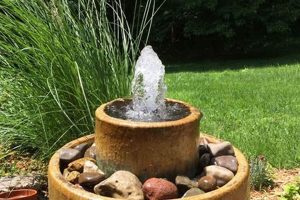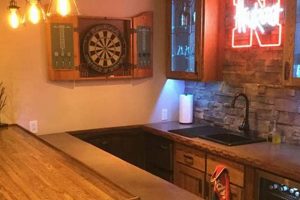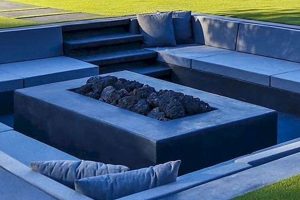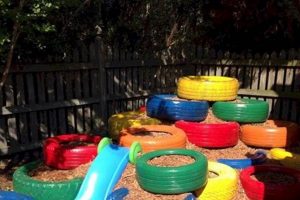The concept involves creative, self-executed border solutions for gardens. These projects often repurpose readily available materials or utilize cost-effective resources to define planting areas and enhance landscape aesthetics. For instance, using reclaimed bricks or stones to create a low wall surrounding a flower bed exemplifies this approach.
Such endeavors offer numerous advantages, including cost savings, customization opportunities, and environmental benefits through the reuse of materials. Historically, garden borders have served practical purposes like containing soil and preventing grass encroachment, evolving into decorative elements that contribute significantly to the overall visual appeal of outdoor spaces.
The following sections will delve into specific material options and construction techniques for creating effective and visually appealing landscape borders. Considerations will include material durability, aesthetic compatibility with existing garden styles, and ease of installation.
Guidance for Implementing Landscape Borders
The following are crucial points for successful project execution. Careful consideration of these elements is paramount for achieving desired aesthetic and functional outcomes.
Tip 1: Material Selection is Paramount: Prioritize durable materials appropriate for the climate. Untreated wood, for example, will degrade quickly in moist environments. Consider alternatives like treated lumber, stone, or recycled plastic edging.
Tip 2: Plan Before You Build: Map out the precise location and dimensions of the borders. Accurate measurements prevent material waste and ensure a cohesive look. Use stakes and string to visualize the final product before commencing construction.
Tip 3: Ensure Proper Ground Preparation: Clear the area of debris, weeds, and rocks. Leveling the ground is critical for stable and even border installation. Use a tamper to compact the soil before placement.
Tip 4: Consider Drainage: Implement drainage solutions if the border will obstruct water flow. French drains or gravel backfill can prevent water accumulation and potential damage to the border and surrounding plants.
Tip 5: Secure the Border Properly: Use appropriate fasteners, such as stakes, landscape adhesive, or concrete, to secure the edging materials. This prevents shifting and ensures long-term stability, particularly in areas with heavy foot traffic or erosion.
Tip 6: Prioritize Safety: Wear appropriate safety gear, including gloves and eye protection, during construction. Exercise caution when using power tools and follow manufacturer’s instructions carefully.
Tip 7: Account for Plant Growth: Design borders with adequate space for plant expansion. Avoid overcrowding plants against the edging, which can lead to root constriction and reduced plant health.
Adherence to these guidelines enhances the durability, functionality, and visual appeal of the resulting border. Careful planning and execution are key for long-lasting results.
The subsequent section will address maintenance strategies for preserving the integrity and appearance of the landscape border over time.
1. Material Durability
Material durability represents a primary determinant of the longevity and overall success of landscape borders. The selection of edging materials directly impacts the structure’s ability to withstand environmental stressors, including moisture, temperature fluctuations, and physical impact. The relationship is causal: inferior materials degrade rapidly, necessitating frequent repairs or replacements, thereby negating the initial cost savings of self-executed projects. Conversely, durable materials ensure prolonged structural integrity, reducing long-term maintenance and preserving the intended aesthetic.
Consider the example of using untreated wood for landscape borders. While initially inexpensive and easily sourced, untreated wood is highly susceptible to rot and insect infestation, leading to structural failure within a few seasons. This necessitates either complete replacement or extensive repair work, significantly increasing the overall cost and labor investment. Conversely, using materials like treated lumber, stone, or recycled plastic, though potentially more expensive upfront, provides significantly greater resistance to environmental degradation. This translates into reduced maintenance, a longer lifespan, and sustained aesthetic appeal.
Therefore, while creative, self-executed border solutions offer customization and cost-saving opportunities, overlooking material durability can prove counterproductive. A balanced approach that prioritizes materials resistant to local environmental conditions is essential for achieving long-term success and minimizing future maintenance. The initial investment in durable materials represents a strategically advantageous decision, ultimately contributing to a more sustainable and aesthetically pleasing landscape design.
2. Cost-Effectiveness
Cost-effectiveness is a central tenet. This directly influences the accessibility and appeal of such projects. The underlying premise involves achieving desired aesthetic and functional outcomes with minimal financial expenditure. The relationship is predicated on resource optimization: employing readily available, low-cost, or recycled materials to create borders that are visually appealing and structurally sound, thereby reducing reliance on expensive pre-fabricated products.
For example, consider the common practice of utilizing reclaimed bricks or repurposed wooden pallets to delineate garden beds. These materials, often acquired at minimal or no cost, offer a tangible reduction in expenses compared to purchasing new edging materials from retail outlets. Similarly, employing locally sourced stone or gravel can significantly lower transportation costs and material expenses. However, cost-effectiveness is not solely defined by the initial material expense. It must also encompass the labor involved, potential tool requirements, and the long-term durability of the materials chosen. Opting for less expensive materials that necessitate frequent repairs or replacements can ultimately prove more costly than investing in more durable, albeit initially more expensive, options.
In conclusion, a holistic approach is required to maximize cost-effectiveness. This entails a comprehensive assessment of material costs, labor requirements, and the projected lifespan of the edging material. Prioritizing readily available, durable, and aesthetically appropriate materials ensures that projects remain financially viable and contribute to a sustainable and visually appealing landscape design. Overlooking any of these elements can undermine the cost-effectiveness proposition, resulting in increased long-term expenses and diminished overall project value.
3. Aesthetic Integratio
n
Aesthetic integration is a critical component. The successful application of self-executed landscape borders hinges upon its harmonious blending with the existing garden design and architectural style of the surrounding structures. A disconnect between the edging and the overall environment diminishes visual appeal, negating the intended enhancement. The relationship is interdependent; the edging serves to accentuate and define the garden’s features, while the garden’s design provides the context for the edging’s visual appropriateness. For instance, a rustic, stacked-stone border may complement a cottage-style garden, whereas a more formal, clean-lined concrete edging might be better suited for a modern, minimalist landscape.
Consider the practical implications of neglecting aesthetic integration. A brightly colored plastic edging installed in a garden dominated by natural stone and muted earth tones would create a jarring visual contrast, detracting from the garden’s inherent beauty. Conversely, the strategic use of complementary materials and colors can enhance the overall aesthetic. For example, using reclaimed brick edging to echo the brick facade of a house establishes a visual connection, creating a unified and cohesive landscape design. Similarly, incorporating plants that spill over the edging softens the lines and integrates the border seamlessly into the surrounding foliage.
In conclusion, aesthetic integration is not merely a superficial consideration. Instead, it represents a fundamental aspect of successful implementation. A thorough assessment of the existing landscape’s style, materials, and colors is essential for selecting edging materials that complement and enhance the overall design. Failure to prioritize aesthetic integration results in a visually discordant landscape, undermining the effectiveness and visual appeal.
4. Installation Simplicity
Installation simplicity is a defining characteristic of successful projects. The ease with which landscape borders can be constructed directly influences the accessibility and appeal. Designs requiring specialized tools, extensive technical expertise, or prolonged labor efforts are less likely to be adopted by the average homeowner. Therefore, the simplicity of installation is paramount.
- Material Weight and Handling
Lightweight materials such as plastic edging or small stones facilitate easy handling and placement. Conversely, heavy materials like large boulders necessitate specialized equipment, increasing installation complexity and cost. Simpler solutions often involve interlocking systems or designs that minimize cutting and fitting.
- Tool Requirements
Projects requiring minimal tools, such as those employing pre-fabricated components or materials that can be shaped by hand, offer increased accessibility. Extensive cutting, drilling, or cementing necessitates specialized equipment and skills, potentially deterring less experienced individuals.
- Ground Preparation Complexity
Simple solutions minimize the extent of ground preparation required. Designs that can adapt to minor irregularities in the terrain are preferable to those that demand perfectly level surfaces. Extensive excavation, leveling, and soil compaction increase installation time and effort.
- Fastening Mechanisms
Straightforward fastening mechanisms, such as stakes, interlocking systems, or simple adhesive application, contribute to installation simplicity. Complex joining techniques or extensive mortar work require specialized skills and increase the risk of errors, potentially compromising the structural integrity of the border.
Ultimately, installation simplicity directly impacts the practicality and feasibility of various landscape border options. By prioritizing ease of construction, individuals can realize the aesthetic and functional benefits of well-defined garden spaces without incurring prohibitive costs or requiring extensive technical expertise. Designs that balance visual appeal with ease of installation are most likely to achieve widespread adoption and long-term success.
5. Maintenance Requirements
The long-term viability of self-executed landscape borders is inextricably linked to their maintenance requirements. The frequency and intensity of upkeep directly influence the overall cost-effectiveness and aesthetic preservation. A comprehensive understanding of these demands is crucial for informed decision-making during the planning and construction phases.
- Material Degradation and Repair
Different materials exhibit varying degrees of resistance to weathering, pest infestation, and physical damage. Wood, for instance, requires periodic sealing or staining to prevent rot and decay, while metal may necessitate rust prevention treatments. Regular inspection for damage, such as cracks, chips, or loose components, is essential for timely repairs and preventing further degradation. The frequency of required repairs directly impacts the overall life-cycle cost of the edging.
- Weed and Grass Encroachment
Landscape borders are intended to define planting areas and prevent the intrusion of unwanted vegetation. However, weeds and grass can often grow along the edges or even through the border materials. Regular weeding and the application of herbicides may be necessary to maintain a clean and defined edge. The choice of border material and its installation depth can significantly influence the susceptibility to weed and grass encroachment.
- Soil Erosion and Displacement
Rainfall and irrigation can cause soil erosion and displacement around the base of landscape borders. This can lead to undermining of the edging and a loss of soil from the planting area. Periodically replenishing the soil and ensuring proper drainage can mitigate these effects. The design and construction of the edging should consider local rainfall patterns and soil types to minimize erosion.
- Aesthetic Upkeep and Cleaning
Even durable materials can accumulate dirt, grime, and stains over time, diminishing their visual appeal. Regular cleaning with water and appropriate cleaning agents can restore the original luster of the edging. Additionally, repainting or restaining wood or metal components may be necessary to maintain their aesthetic qualities. The amount of time and effort required for aesthetic upkeep should be considered during the material selection process.
The preceding points underscore the significance of maintenance requirements in the context of. Careful consideration of these factors during the design and construction phases is essential for ensuring long-term viability and aesthetic preservation. Selecting materials and construction techniques that minimize maintenance demands contributes to a more sustainable and cost-effective landscape design.
6. Soil Containment
Soil containment represents a primary function of landscape borders. Effective containment prevents soil erosion, maintains defined planting areas, and promotes healthy plant growth. The absence of proper soil containment leads to soil loss, nutrient depletion, and the intermingling of different planting zones. Therefore, soil containment is an indispensable component of any successful landscape border implementation.
The connection between soil containment and landscape borders is causal. The design and construction directly influence the ability to retain soil within designated areas. Low-lying borders or those constructed with permeable materials may be ineffective in preventing soil erosion, particularly on slopes or in areas with heavy rainfall. In contrast, borders that are sufficiently tall, structurally sound, and impermeable provide effective soil containment. For example, a well-constructed retaining wall using interlocking blocks effectively prevents soil erosion on a sloped garden bed, while a simple border of loosely placed stones provides minimal soil retention. Furthermore, the choice of materials influences soil moisture levels. Porous materials allow for better drainage, preventing waterlogged soil conditions, while impermeable materials may require drainage considerations to prevent water accumulation.
In summary, the effectiveness in preventing soil erosion and maintaining defined planting areas directly depends on its design and construction. Prioritizing appropriate materials and construction techniques that provide adequate soil retention is essential for creating sustainable and aesthetically pleasing landscape borders. Failure to address soil containment results in compromised plant health, increased maintenance requirements, and a diminished overall visual appeal.
7. Weed Control
Effective weed control is intrinsically linked. The presence of weeds compromises the aesthetic appeal and overall health of a garden. Implementing a well-designed landscape border serves as a physical barrier, mitigating weed encroachment and reducing the need for herbicides. The connection operates through several mechanisms: the border physically blocks the spread of weeds from adjacent areas, it defines the planting zone, facilitating targeted weed removal, and it can incorporate weed-suppressing materials, such as landscape fabric, beneath the edging.
The practical application is evident in various contexts. Consider a garden bordered with deeply installed paver stones. The stones act as a barrier against creeping grasses and weeds from the surrounding lawn, reducing the need for manual weeding. Similarly, a border incorporating a buried section of metal or plastic edging effectively prevents rhizomatous weeds from spreading into the garden bed. Incorporating landscape fabric beneath any type of edging material provides an additional layer of protection, preventing weed seeds from germinating in the soil. Failure to integrate weed control measures results in increased maintenance demands, compromised plant health, and a diminished aesthetic appeal.
In conclusion, proactive weed control measures are an essential component of. Integrating weed-suppressing materials and constructing a physical barrier effectively reduces weed encroachment, minimizing maintenance requirements and promoting a healthy, visually appealing garden. Neglecting weed control during the border design and installation phases ultimately undermines the long-term success of the project.
Frequently Asked Questions
The following section addresses common inquiries regarding the design, construction, and maintenance of garden borders.
Question 1: What factors determine appropriate material selection?
Material selection should prioritize durability, cost-effectiveness, aesthetic compatibility with the existing garden design, and ease of installation. Climate conditions must be considered to prevent premature degradation. Budget constraints and the overall desired aesthetic also influence material choices.
Question 2: How is weed encroachment effectively mitigated in landscape borders?
Effective weed control involves several strategies: physically blocking weed spread with a deep border installation, incorporating weed-suppressing materials like landscape fabric beneath the edging, and consistent manual removal of any emerging weeds. Pre-emergent herbicides may be considered judiciously.
Question 3: What considerations are paramount for ensuring long-term border stability?
Long-term stability requires adequate ground preparation, proper border material installation using appropriate fasteners, and consideration of drainage to prevent water accumulation. The choice of durable materials resistant to local environmental conditions is also critical.
Question 4: How should differing soil types influence edging design?
Soil type affects drainage and the need for soil containment. Sandy soils require deeper borders to prevent erosion, while clay soils may necessitate drainage solutions to prevent waterlogging. The border material’s permeability should align with the soil’s drainage characteristics.
Question 5: What are the advantages of using recycled materials for landscape borders?
Employing recycled materials reduces environmental impact, lowers material costs, and offers unique aesthetic opportunities. Reclaimed bricks, repurposed wood, and recycled plastic represent viable and sustainable options.
Question 6: How does the selection of edging material impact plant health?
The choice of edging material can influence soil temperature and moisture levels, directly impacting plant health. Materials that retain heat may be detrimental to sensitive plants, while impermeable materials can impede drainage. Consider the specific needs of the plants when selecting edging materials.
In summary, successful relies on careful planning and a holistic approach, encompassing material selection, installation techniques, weed control measures, and ongoing maintenance.
The subsequent section will explore specific design ideas and innovative approaches to landscape borders.
Conclusion
The preceding analysis has illuminated the multifaceted considerations involved in the realm of landscape borders. The exploration spanned material selection, installation techniques, aesthetic integration, and long-term maintenance implications. Effective projects necessitate a strategic approach, balancing cost-effectiveness with durability and aesthetic appeal. Success depends on rigorous planning and informed execution.
The principles outlined provide a foundation for creating functional and visually pleasing landscape borders. The long-term benefitsimproved garden aesthetics, reduced maintenance efforts, and enhanced plant healthjustify the initial investment in planning and execution. Continued adherence to these principles is critical for realizing sustained benefits and contributing to a landscape of lasting value.







